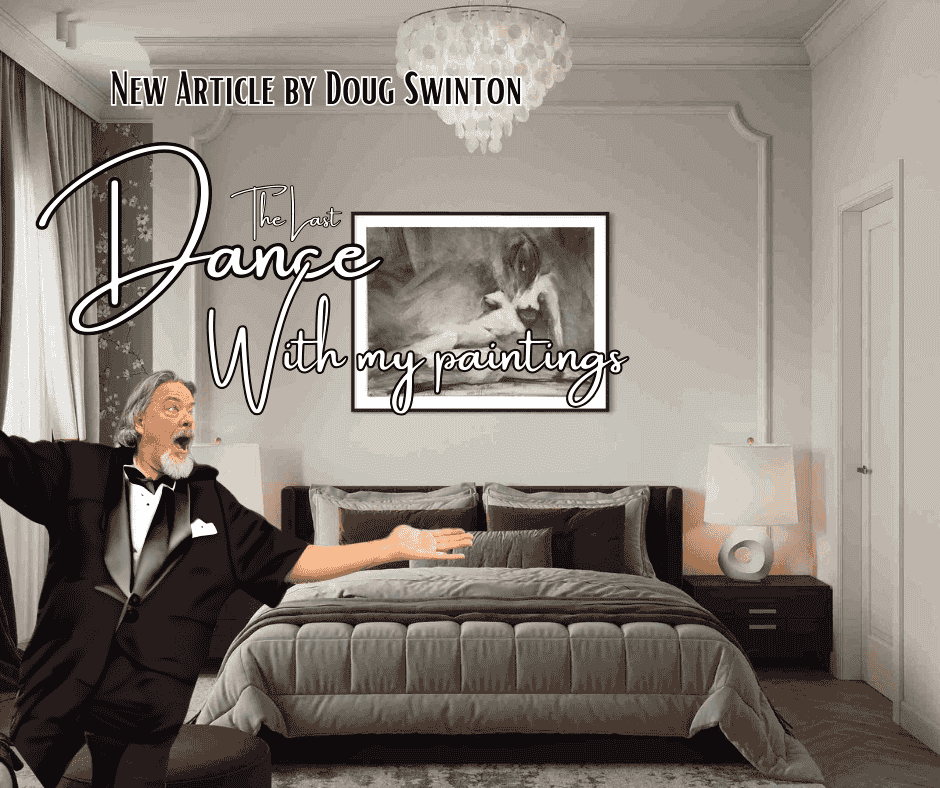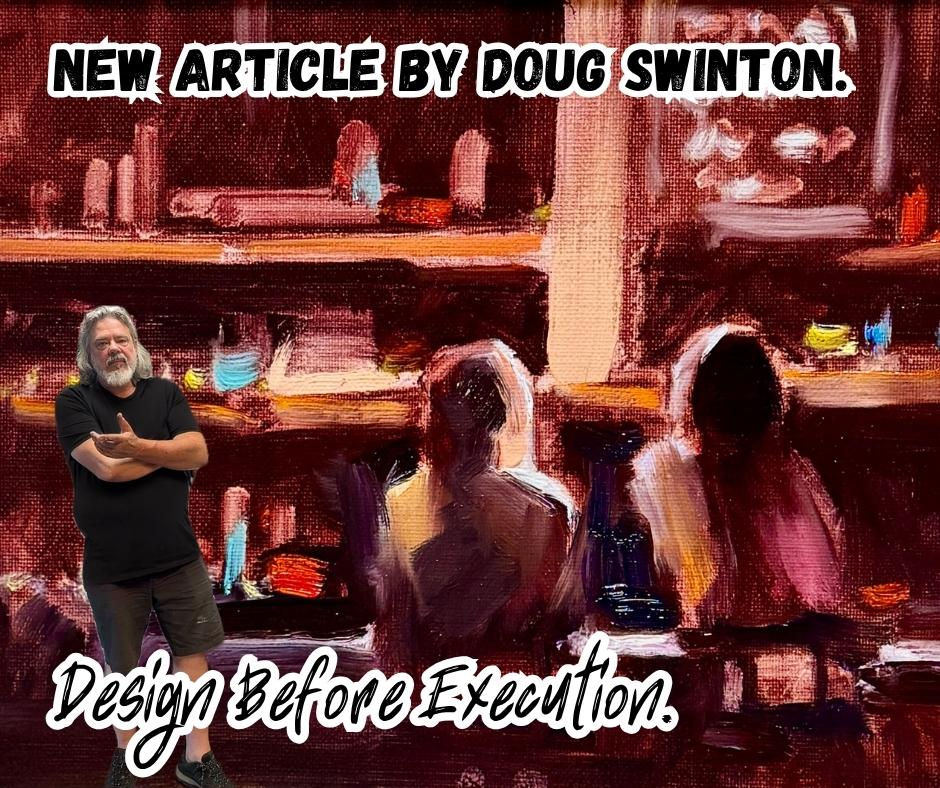10 things that offset the start of a painting.
- Doug Swinton

- Oct 30, 2020
- 5 min read
Updated: Mar 15, 2021
The start of a painting is sooooo important. It sets you up for success. If your start is good the chances are, you will have a good painting. The first few lines let you know you're on the right track. Nothing worse than having to do a barn-ectomy in the middle of a painting. If you need to move your barn halfway through the process you in deep doo-doo. Here is a list of things that will help you start out on the right foot.
#1 - Bad Reference
9.9 times out of 10 a bad painting comes from a bad reference. People seem to think that because they’re going to paint the photo it will magically turn into a masterpiece. It won’t. It will turn into a mess-ter-piece. Choose photos with good lighting, strong shadows, simple shapes and please please please don’t choose a photo of a picnic with your favourite aunt on a hill from far away on the worlds most cloudy day. It won’t work and nobody cares about your aunt no matter how much wine she had.

Bad reference. This looks like it was taken with one of those flat 110 film cameras we used in the ’70s. It’s overexposed, grainy, and full of useless information. (The colour is all washed out & the temperatures are hard to read.)

Good reference. 70% warm 30% cool. Large foreground, medium middle-ground and small background.

Good photo = Good painting
Good side lighting with warms and cools.

#2 - Wrong size of canvas for the photo or your sketch.
This happens all too often.
- Choose a photo,
- Do a sketch,
- Draw up your sketch to paint.
- Now let's choose the proper size canvas.

Here is the photo… You may even sketch the same dimension but then suddenly the canvas you chose is the wrong ratio.

The canvas you choose… umm square?? So squishy cows now?? oopsy! wrong ratio.

This is a more appropriate size. Choose a canvas or paper size in the same ratio as your photo and your composition will be accurate.
#3 - Dirty thinner or water to start.
Not having clean brushes or clean water/thinner, to begin with, is a major faux pas. Start clean and please try to work clean throughout. This goes for clean brushes and a clean palette. Start clean and fresh so when the Muse enters your studio she does not soil her dress.
When you're using your thinner and it starts to mussy your colours it's time to change it out.
#4 - Unclear thoughts of where you’re going.
Envision your painting. If you can imagine what your painting will look like as a finished piece you will have an easier path to getting there. It's not that the painting won’t take some twists and turns but you will have a better chance of having success if you have some kind of direction to follow. Besides just your reference photo.
#5 - Biting off more than you can chew.
A lot of times artists will take on a painting that is way beyond their capabilities. Pushing the envelope is one thing but going way out on a limb is another. You get in way too deep.
and you can’t get out. Too many shapes, too much detail and too many colours may cause you to get confused. Remember simple sells. You don’t need a grand subject for a painting.
In his book Hawthorne on Painting, Charles Hawthorne states “even something as simple the twinkle of light in a dishpan of water is fodder for an artist”.
#6 - Bad easel of working equipment.
Having a wobbly easel, uneven desk, rickety equipment is very detrimental to making good art. If your subconscious is thinking about holding the painting or steading a table your creative mind won’t kick in. You will be continually trying to rectify the problems of equipment and this will be distracting from the task at hand. It's not that you need anything super fancy, just equipment that doesn't break your concentration.
#7 - Wrong surface for the type of painting you’re going to do.
Marrying the surface to the media you’re using is paramount to having a successful painting. Say you want a thick chunky painting, you don’t want to use a super smooth canvas. It’s just way too slick and you will end up with a smudgy mess. This is where some experimentation comes in. It takes a bit to learn about all the different surfaces you can work on and what style of media you can use but it’s part of the fun of learning what works with what.
#8 - Thinking the painting sucks when you’re just in "The ugly duckling stage".
Having a good start can be such a positive experience. Things are rolling along merrily, then slowly they start to fall off the rails. You get to what I call "The ugly duckling stage". This is where you’re not sure where the painting is heading. “Had such a good start but now I’m not so sure where this is going” Just gotta keep slogging thru. Don’t question it. As Robert Wood says "You don’t stop mid-hair-cut and say well this looks like poop. I should quit. You keep cutting, wait to see the final product."
#9 - Shadows too dark to start.
I see this all too often. Painters use their darks too dark at the beginning. This has a tendency to make you paint your lights too dark and the painting takes on a muddy almost ominous feel. As a general rule, shadows on things like trees or sides of buildings should be a value 5 (in the greyscale). Cloud shadows are a value 4. Keep your shadows the right value and you will have a fresh painting.
(You are using your value finder? Aren't you?)
#10 - Starting with too many shapes.
No more than three to 5 shapes, please. Any more and it gets confusing, not only for the viewer but for you as the artist to paint.

This painting is all about the 4 shapes


This painting is all about the 4 shapes

At least 6 shapes are going on here. Way too many.

This photo only has too few shapes. Having too many shapes is one thing but too few is another.
Here is a bonus list of other common mistakes artists make at the beginning or during the painting session.
- Placing the main focal point in the centre of the painting.
- Painting with small brushes, in the beginning, You can’t paint the fleas on the dog till you have painted the dog.
- Having the same amount of details in the foreground and background. Big and bold upfront and soft and splotchy at the back, please.
- Using greens straight out of a tube. One word…..EWWWWWW. Always mix your greens.
- Being stingy with paint. It’s like baking a cake using fewer eggs and still expecting it to turn out.
-Including everything you see, less is more…edit edit edit.
-Worrying about the results. Relax, have fun. In art, the journey outshines the destination.
Your friend in art, Doug.
Monthly Sales

15% OFF All Studio Easels

20% OFF Eco-House Odourless Thinner

20% OFF Rembrandt Oil Paints!

20% OFF Daniel Smith Watercolours

15% OFF Winsor & Newton Galeria Acrylics

20% OFF Princeton Synthetic 6300 brushes
Upcoming Events

Watercolour Magic · Rex Beanland

Mixed-Media Workshop! "Flower Fun"

Printmaking · Linocut & Monoprint (Beginner)

Watercolour Sampler

Acrylic Sampler
Thanks for reading!








bom.win chú trọng bảo mật thông tin, áp dụng công nghệ mã hóa tiên tiến nhằm đảm bảo an toàn tuyệt đối cho mọi giao dịch.
Người chơi có thể dễ dàng tham gia các chương trình khuyến mãi hấp dẫn, nhận thưởng và quà tặng đặc biệt từ <a href="https://w88link3.com/">w 88</a> mỗi tuần.
ev99.ru.com được biết đến là một nền tảng giải trí trực tuyến hiện đại, mang đến cho người dùng nhiều trải nghiệm hấp dẫn cùng giao diện thân thiện và dễ sử dụng.
ok9c.net cập nhật liên tục các chương trình khuyến mãi và ưu đãi hấp dẫn dành cho thành viên mới cũng như người chơi lâu năm.
nhà cái bot88 là nền tảng giải trí trực tuyến được nhiều người yêu thích nhờ giao diện thân thiện, tốc độ truy cập nhanh và bảo mật tuyệt đối.